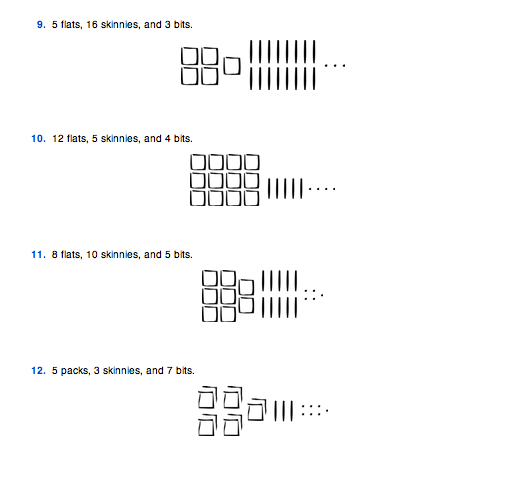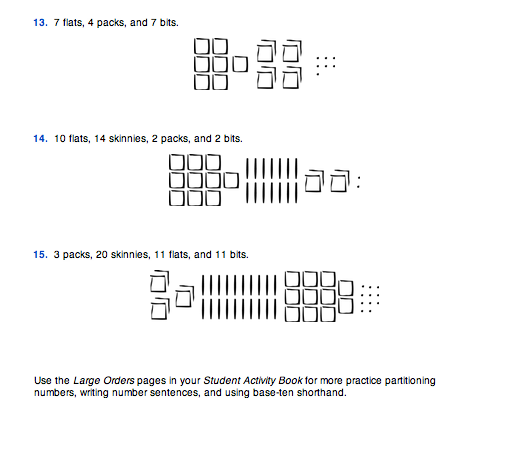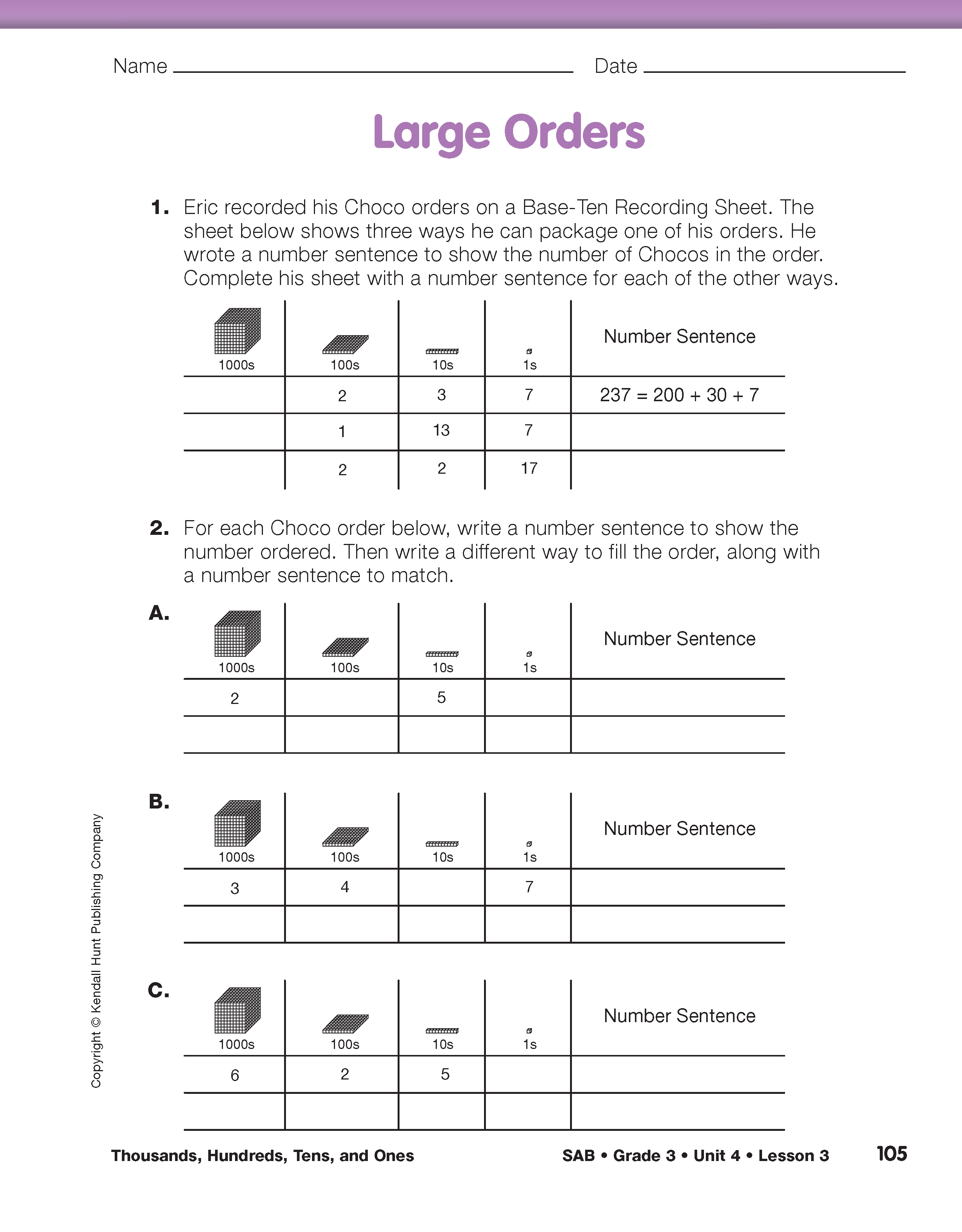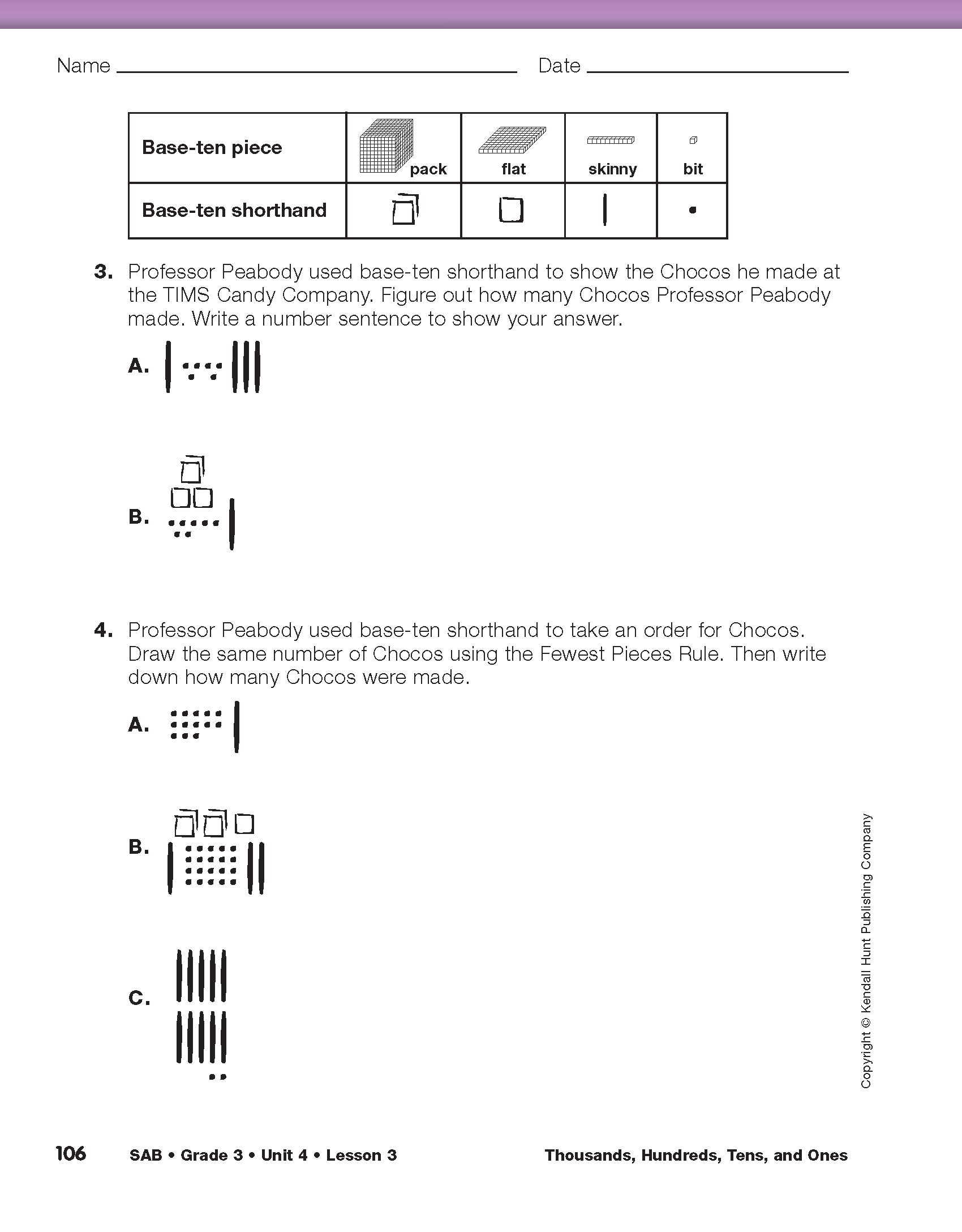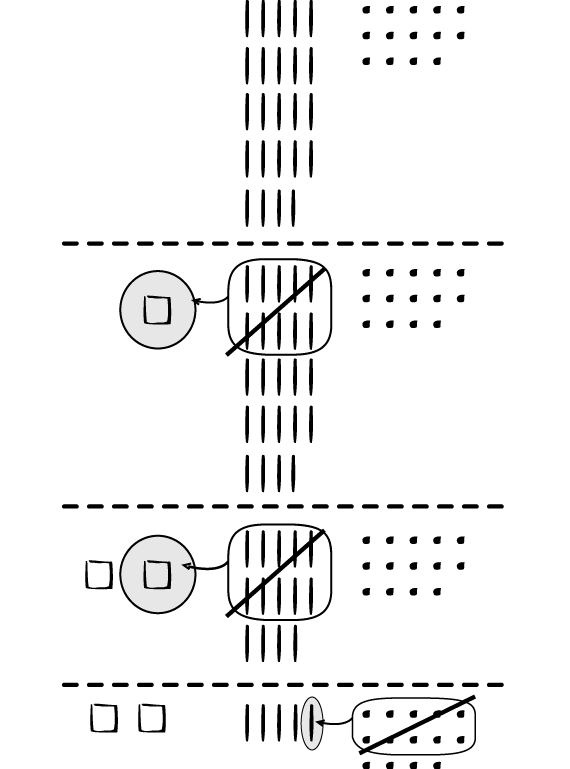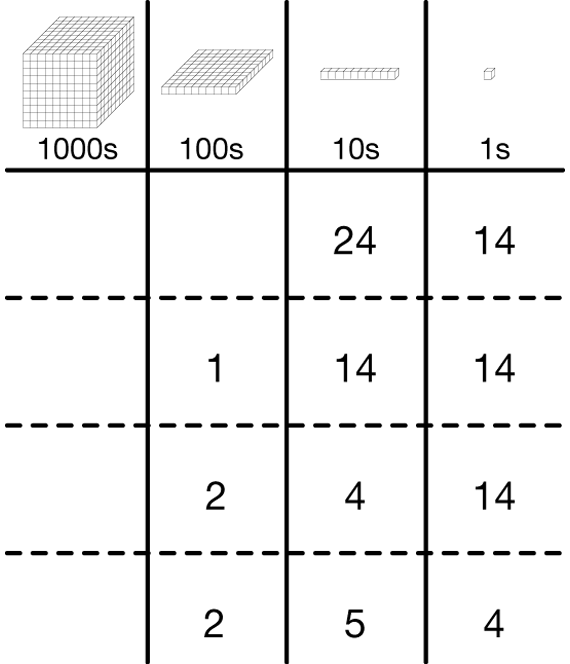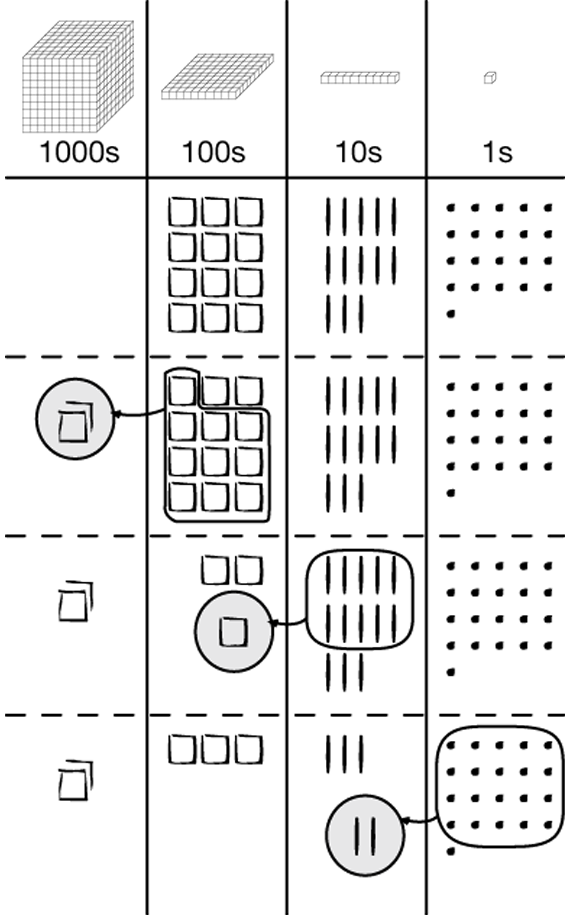Make Trades to Get Fewest Pieces. In Parts 1 and 2, students represented the partitions of numbers with base-ten pieces. In this part, they do the opposite. They determine what number is represented by a collection of base-ten pieces. You can think of the pieces as packages for the TIMS Candy Company. Then the question becomes, “How many Chocos are in the packages?”
If a number is represented using the fewest pieces, then it is easy to tell what number it is. The number of bits (ones) in the fewest pieces representation tells the first digit on the right, the number of skinnies tells the second digit, and so on.
If a number is not represented using the fewest pieces, then students should trade 10 pieces for the next largest piece until all trades have been made. The following discussion prompts help you review the Fewest Pieces Rule from Lesson 2.
Show students 14 skinnies and ask:
- What number do these 14 skinnies represent? How do you know? (140. Students may skip count by tens to 140 or trade ten skinnies for one flat and count 100, 110, 120, 130, 140.)
- Have I shown this number using the fewest pieces with 14 skinnies? How do you know? (No. You have more than ten skinnies. You can trade ten skinnies for a flat.)
Show the two representations and write 140. Note that both of these represent 140 (Chocos).
- Which representation matches the digits in the number? How? (The fewest pieces because one flat is 100 and the 4 skinnies are 40. There are no bits. That's the zero.)
Show 24 skinnies and 14 bits.
- Work with your partner and use your pieces to make trades to represent this number using the fewest pieces.
One possible set of trades is shown in Figure 2.
Note that the order of trading shown in Figures 2–4 is not right to left as is customary in the standard pencil-and-paper algorithm. It is natural for some students to start with the largest block. It is important to allow students to make the trades that make sense to them.
Model recording a student trading using numbers on a display of the Base-Ten Recording Sheet 1 Master as shown in Figure 3.
- What number is this? Can you easily tell what this number is?
If the number is not represented with the fewest pieces, then the number will not be obvious.
- What will help us know what this number is? (Making more trades until we have the fewest pieces.)
- Have I shown this number using the Fewest Pieces Rule?
- What trades should I make to show this number following the Fewest Pieces Rule? (Trade 10 bits for 1 skinny.)
Ask students to work with partners to set the following groups of base-ten pieces on their desks and then make trades according to the Fewest Pieces Rule. Ask them to record their work on a Base-Ten Recording Sheet.
- 12 skinnies and 8 bits (Trade 10 skinnies for one flat. 128 Chocos.)
- 19 bits and 15 skinnies (Trade 10 skinnies for one flat and 10 bits for 1 skinny. 169 Chocos.)
- 11 flats, 3 skinnies, and 15 bits (Trade 10 bits for 1 skinny and 10 flats for 1 pack. 1145 Chocos.)
- 1 pack, 4 skinnies, 2 bits, and 10 flats (Trade 10 flats for 1 pack. 2042 Chocos. Discuss the use of zero to show there are 0 flats in the fewest pieces.)
- 21 bits, 12 flats, and 13 skinnies (1351 Chocos. See Figure 4.)
- 2 flats, 22 bits, 8 skinnies (Trade 20 bits for 2 skinnies and 10 skinnies for 1 flat. 302 Chocos. Discuss the use of zero to show there are no skinnies in the fewest pieces.)
Make sure students are trading pieces correctly. Students' records should look similar to the table in Figure 3 (recording trades with numbers for 254) or Figure 4 (recording trades with base-ten shorthand for 1351) but the order of trading can be different.
Counting Chocos. Have students solve Questions 7–15 in the Student Guide. As students work, ask questions that will help them make the connections between numbers and base-ten pieces. In particular, discuss the need for using zeros in the numbers in Questions 11–13. For example, there are 9 flats (hundreds) and 5 bits (ones) in the representation with the fewest pieces for Question 11. To write the number 905, it is necessary to use a zero to show there are no skinnies (tens).

- If students are having difficulty making trades using base-ten shorthand, have them use base-ten pieces to make the trades.
- Students may lose track of pieces as they make multiple trades. Ask them to find a way to organize their pieces on the desk, so that when they make trades the total number of Chocos remains the same.
- A common mistake students make when learning to write numbers is to write out each part of the number the way it sounds. For example, they incorrectly write 123 as 10023 because they hear 100 in its name. Writing number sentences helps students realize that they need to add the values of the pieces to get the number.
Write Number Sentences. Ask students to work in pairs to answer Questions 1–4 on the Large Order pages in the Student Activity Book. Questions 1 and 2 give students more practice partitioning numbers and writing number sentences to match. Questions 3 and 4 provide practice with determining the number represented with base-ten shorthand.
When students have completed the questions, discuss the use of zeros in Questions 2A, 2B, 2C, 4B, and 4C. Some students will understand the values of the shorthand symbols and can solve the problems easily. Encourage students to first model the number with pieces if they have trouble with the shorthand notation.
- In Question 2A, how many flats and bits were in the Choco order shown? Bits? (Zero flats and zero bits.)
- How did you show that in the number sentence? (I wrote 2000 + 50 because there were 2 packs, 0 flats, 5 skinnies, and 0 bits.)
- How is that shown in the number you wrote? (In 2050, the zeroes show there are no flats and no bits.)
- Does 3000 + 400 + 7 = 3470? Show or tell how you know. (No. 3000 + 400 + 7 is 3 packs, 4 flats, and 7 bits. There are no skinnies. But 3470 has 7 skinnies, so they are not equal.)
- In Question 2B, how are no skinnies shown in the number 3407? (There is a zero in the tens place in 3407.)
- In Question 4C, what number did you write for 10 skinnies and 2 bits? (102)
- What does the zero in that number mean? (If I trade the 10 skinnies for 1 flat, there is 1 flat, 0 skinnies, and 2 bits.)














